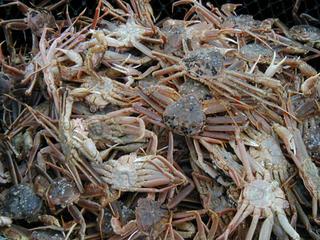Snow Crab Gear Losses Total $1M

Monday, July 02 2012
Heavy ice in the Bering Sea this winter carried away a mountain of crab gear. Fishermen lost about 800 pots over the course of the snow crab season, or about six percent of their total gear.
“Just for comparison, in the past two snow crab seasons, gear loss rates were between 1-2 percent," says Alaska Department of Fish and Game biologist Britta Baechler.
Each crab pot is worth between $1000 and $1500, which means the fishery lost about a million dollars worth of gear overall. This year’s record-breaking sea ice is the primary culprit. The ice can cut buoy lines or drag pots miles from where they were set. Baechler says the doubling of the snow crab quota was probably also a factor.
“So we kind of expected that a few more pots might be lost, but we certainly weren’t expecting this much gear to be left in the water.”
In addition to the immediate economic losses for fishermen, the so-called ‘ghost pots’ also cost the fishery in the long run. Lost pots can continue fishing the seafloor for months, trapping crab and other marine critters. Fish and Game biometrician Bill Gaeumen says it’s hard to say for sure what happens to those animals, but, “common sense suggests that if you trap animals in a place where they can’t go about their business for long enough, it’s probably not good.”
The pots do have a built-in ‘safety valve’ of sorts - a patch of cotton twine that biodegrades over time, leaving a hole that animals can enter and exit. But Gaeumen says it can take months for the twine to degrade and in the meantime, animals can pile up inside the pots.
“Clearly we don’t want crab being killed off, just for no reason like that. Lost to the fishery, to the the ecosystem. All those things considered, it’s not a good thing to be murdering off crab out there. We just don’t know how extensive that could be.”
Gaeuman says there’s no good information about how the ghost pots ultimately affect the Bering Sea crab populations.
Estimates vary widely about how many ghost pots are on the fishing grounds, but previous studies indicate it could be on the order of tens of thousands.
IN RESPONSE to this article, an editorial from the Alaska Bering Sea Crabbers about ghost fishing:




Joe T. Plumber on Friday, July 13 2012:
Alaska Bering Sea Crabbers??? So the multi-millionaire boat owners are upset and they write a rebuttal to a benign and common sense article. I think it stands to reason that for some period of time if a pot is left on the bottom that it continues to fish. So the bait may break down in a few days, the bio-twine doesn’t. Anyone that has dealt with pots or watched that Discovery show also knows that the pots not only trap crab, but fish. It would therefore stand to reason that the fish that are trapped will also attract crab, hence the ghost fishing... Come on people bio-twine is great, but maybe it would be better to not push the limits and lose the pots (I know it was wasn’t purposeful).